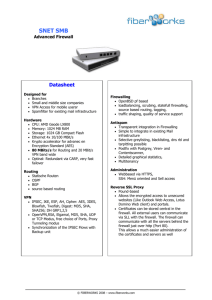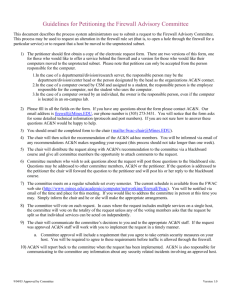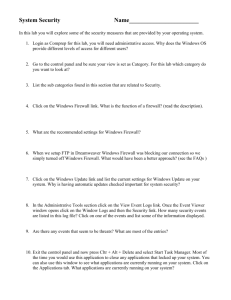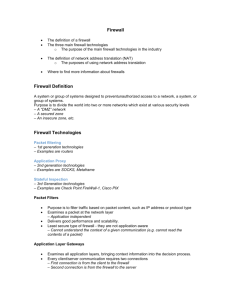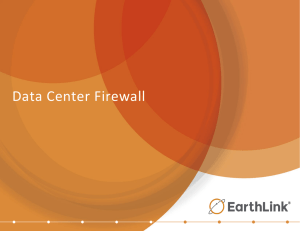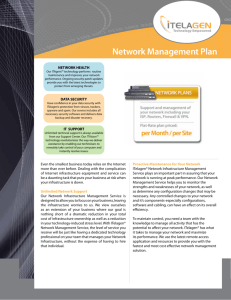a systematic methodology for firewall penetration testing
advertisement
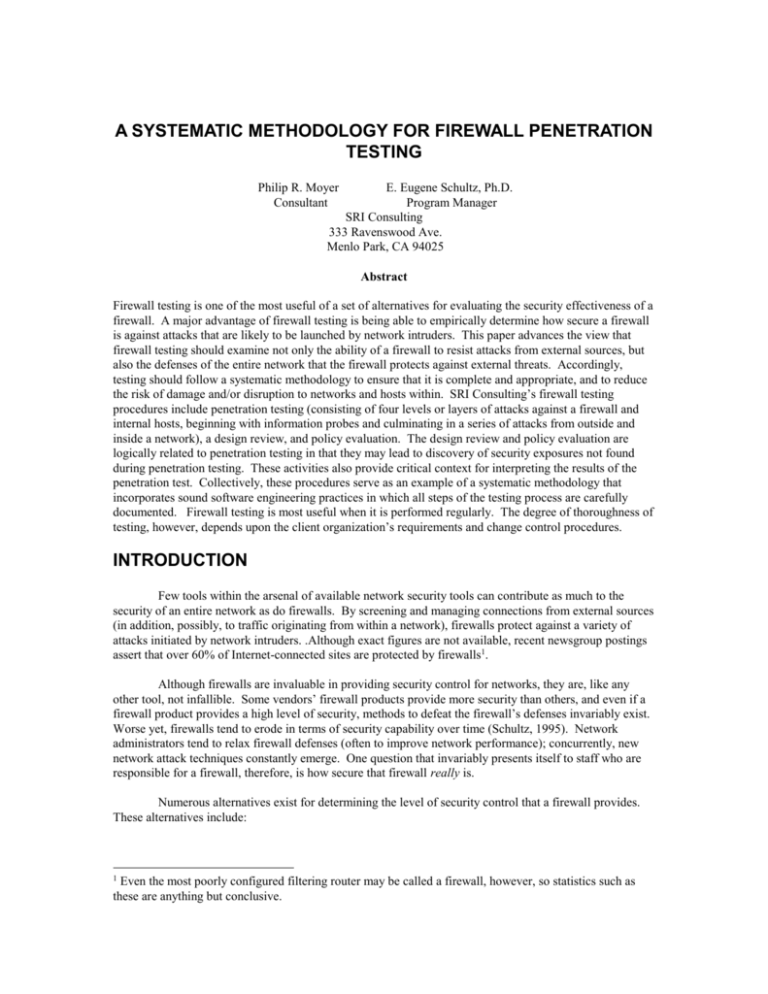
A SYSTEMATIC METHODOLOGY FOR FIREWALL PENETRATION TESTING Philip R. Moyer Consultant E. Eugene Schultz, Ph.D. Program Manager SRI Consulting 333 Ravenswood Ave. Menlo Park, CA 94025 Abstract Firewall testing is one of the most useful of a set of alternatives for evaluating the security effectiveness of a firewall. A major advantage of firewall testing is being able to empirically determine how secure a firewall is against attacks that are likely to be launched by network intruders. This paper advances the view that firewall testing should examine not only the ability of a firewall to resist attacks from external sources, but also the defenses of the entire network that the firewall protects against external threats. Accordingly, testing should follow a systematic methodology to ensure that it is complete and appropriate, and to reduce the risk of damage and/or disruption to networks and hosts within. SRI Consulting’s firewall testing procedures include penetration testing (consisting of four levels or layers of attacks against a firewall and internal hosts, beginning with information probes and culminating in a series of attacks from outside and inside a network), a design review, and policy evaluation. The design review and policy evaluation are logically related to penetration testing in that they may lead to discovery of security exposures not found during penetration testing. These activities also provide critical context for interpreting the results of the penetration test. Collectively, these procedures serve as an example of a systematic methodology that incorporates sound software engineering practices in which all steps of the testing process are carefully documented. Firewall testing is most useful when it is performed regularly. The degree of thoroughness of testing, however, depends upon the client organization’s requirements and change control procedures. INTRODUCTION Few tools within the arsenal of available network security tools can contribute as much to the security of an entire network as do firewalls. By screening and managing connections from external sources (in addition, possibly, to traffic originating from within a network), firewalls protect against a variety of attacks initiated by network intruders. .Although exact figures are not available, recent newsgroup postings assert that over 60% of Internet-connected sites are protected by firewalls1. Although firewalls are invaluable in providing security control for networks, they are, like any other tool, not infallible. Some vendors’ firewall products provide more security than others, and even if a firewall product provides a high level of security, methods to defeat the firewall’s defenses invariably exist. Worse yet, firewalls tend to erode in terms of security capability over time (Schultz, 1995). Network administrators tend to relax firewall defenses (often to improve network performance); concurrently, new network attack techniques constantly emerge. One question that invariably presents itself to staff who are responsible for a firewall, therefore, is how secure that firewall really is. Numerous alternatives exist for determining the level of security control that a firewall provides. These alternatives include: 1 Even the most poorly configured filtering router may be called a firewall, however, so statistics such as these are anything but conclusive. 1. Making a decision based on information provided by vendors. Although easy to do, this method is limited by the nearly universal tendency of vendors to make only positive information about their products available to customers and potential customers. 2. Relying on generic evaluations of vendor-supplied firewall products performed by an independent entity or organization. This approach is superficially appealing, but is in all likelihood limited by the same practical difficulties that have diminished the value of anti-virus product comparisons in the past.2 In addition, the applicability of the results of this approach diminishes to the degree that an organization modifies the out-of-the-box configuration of the firewall. 3. Analyzing a firewall’s design and configuration. This approach is attractive, and we will further discuss it later in this paper, but suffice it to say at this point that careful analysis of a firewall does not provide empirical data concerning a firewall’s effectiveness and is not likely to identify every security weakness that exists. 4. The final alternative and focus of this paper is firewall penetration testing (simply called “firewall testing” hereafter). During a firewall test, security personnel, usually from outside the target organization, attempt to break into the target firewall system from an external location on the network, which most frequently is the Internet. The testing techniques are based on attacks real network intruders use. If conducted properly, firewall testing usually provides the most direct and convincing evidence about the effectiveness of a firewall. Knowing that a firewall can withstand the same attacks that network attackers actually use produces a high level of confidence in the firewall. Failure to withstand such attacks reveals specific security exposures to remedy in the firewall. Discovering these exposures and fixing them before intruders find them is another advantageous outcome of firewall testing. Empirically determining the level of protection provided by firewalls is, therefore, extremely important A major problem with the current practice of firewall testing, however, is that a great deal of this activity is conducted with too much emphasis upon attack techniques, but insufficient emphasis upon sound testing methodology. Too often a firewall test is viewed as a kind of “hackathon.” Organizations may authorize someone to conduct the testing, but this person may “disappear behind a black curtain,” then return to report the findings. So ends the firewall test. Although the test itself may have appeared satisfactory to the organization, the test may have been conducted in a less-than-competent manner. The person conducting the test may, for example, have conducted only a few, rather non-rigorous tests. Worse yet, this person may have been haphazard in conducting the test, perhaps putting at risk network services in addition to data residing on hosts behind the firewall. The organization may never be aware of the methodology that the person who has tested the firewall has used, even though the meaning of the test results are highly dependent upon the type and quantity of tests that have been conducted. The person conducting the test may also not have systematically recorded the steps that were taken and the results of each. One likely result is that the client organization may be misled concerning the security state of its firewall(s), or may be unable to replicate the testing procedures or to understand the specific nature and symptoms of any exposures that surface because of the lack of detailed testing procedures and/or documentation. In short, too many firewall tests are conducted in the absence of a systematic and guiding methodology. Firewall tests conducted in this manner have extremely limited value, and can even be risky, causing disruption of ongoing network operations in addition to political fallout. The primary purpose of this paper is to describe a methodology that SRI Consulting has been using to perform real-world firewall tests for nearly two years. We describe this methodology as an example of the use of a systematic approach 2 The results of anti-virus product testing are often open to challenge because the organization performing the testing may use an older version of a vendor’s product when a new, more effective release is imminent. In addition, what constitutes a representative set of viruses against which to test products is an unsolved issue. Parallel issues face those who want to test firewalls in a similar manner. to testing firewalls in the hope that it will both lead to a better understanding of the technology of effective firewall testing and elevate the practice of firewall testing. PRELIMINARY CONSIDERATIONS The beginning point of a sound firewall test is understanding the basic purpose and logic of testing firewalls. Different organizations may have different specific requirements with respect to firewall testing, but the fundamental purpose of a firewall test is not merely to test the security provided by a firewall machine (although this is often one element a firewall test). Routers may, for example, also perform important security screening functions for inbound traffic. A good firewall test is geared not only upon attacking a firewall system, but also upon additional elements. A major purpose of firewalls is to create a security perimeter around an entire network (Cheswick & Bellovin, 1994); a firewall is simply one component of the network that is designed to create such a perimeter. The real purpose of a firewall test is to evaluate the security of the entire network with respect to the possibility of entry from an external location. Some of the most basic questions that firewall testing should answer are: 3 1. Does the firewall properly enforce an organization’s firewall policy? 3 The rules that determine whether a firewall accepts or denies incoming traffic are embodied in a firewall policy. An effective firewall is, among other things, a correct implementation of this policy (Power, 1995). Testing to determine whether or not the implementation is congruent with the firewall policy is certainly one of the most fundamental issues. Some policies, however, are so poorly formulated that they cannot be tested. If the policy says, for example, that "The network shall be resistant to all external attacks," then the firewall test cannot verify compliance. If in contrast the firewall policy says, "The network shall not allow external NFS traffic," then a firewall test can indeed verify compliance. 2. Do the firewall and other components within a network properly enforce an organization’s network security policy? A firewall policy is certainly critical, but a good firewall policy is only one part of an overall network security policy. The network security policy should specify which services should be available, both internally (within the network) and externally, whether or not source routing is allowed, the baseline level of security controls for hosts within the network, the security maintenance policies to be followed, and so forth. Because a firewall host is a component within a network, it is subject to the security standards and guidelines that apply to the network. Every network component that affects enforcement of the network security policy should be tested. A firewall test should also reflect this consideration. 3. Independently of all other considerations, how well does the firewall and other network components provide protection against externally initiated attacks? To what specific attacks are the firewall and other network components vulnerable? The firewall and network security policies may have omissions that can leave a correctly implemented firewall wide open to attacks. Firewall testing can provide a reasonable indication of the ability to resist attacks and can lead to identification of such policy omissions. 4. How effective is the network’s security perimeter? Does leakage, an access route to a network that bypasses the firewall’s defenses, exist? The firewall itself may be perfectly secure, but if an organization’s research and development function runs its own T1 link to the Internet, the firewall is of very limited value. The firewall testing team's job should ideally be to find the line set up by the research and development function and run through the internal networks, then attack the Ideally firewall testing is an outgrowth of the firewall policy in that the policy can be interpreted as a set of requirements against which testing occurs. If no firewall policy exists, the meaning of the outcome of a firewall test becomes ambiguous in that no explicit requirements against which to test the firewall exist. firewall from the inside. Finding leakage may not necessarily involve testing the firewall exclusively, but nevertheless in many cases should constitute an important part of a firewall test. 5. How much information about a network is available from outside a network? Information concerning a network’s infrastructure aids attackers by allowing them to map internal routing and network configurations. Discovering whether this information is available to external users is thus a justifiable part of firewall testing, even though most firewalls themselves are generally unable to control the dissemination of all information from within a network. 6. Do the firewall and other machines within the target network generate alarms when attacks are launched? Because ability to detect attacks is one of the most valuable functions of an effective firewall. testing this ability is also an important part of firewall testing. Note that a firewall test cannot assure that a given network is secure. This test may provide some indication of the security state of a network, but, to reiterate, the focus of a firewall test is the susceptibility of the target network to externally-initiated attacks. The hosts within a network may be very poorly configured from a security perspective, and may have legions of unpatched vulnerabilities. A firewall may block all external access to these hosts, making the security of the network appear to be extremely high, yet these hosts (including the firewall host!) may be an extremely easy target for anyone who accesses them from within. Remember, too, that firewall testing that is not conducted properly can quickly get out of control and cause extremely negative consequences. Resolving issues such as obtaining management approval in advance, having detailed, written procedures and following them, allowing only people with high personal integrity to perform testing, ensuring in advance that any attack scripts used will not damage or disrupt systems, and others is every bit as important as the technical side of a firewall test (Schultz, 1996). METHODOLOGY Our firewall testing methodology consists of three related sets of activities. The first part is the penetration test involving attacks on the firewall and hosts behind the firewall. Many people view attacks upon a firewall as an end unto itself, but several additional activities can shed considerable light on the meaning of the test results. We thus include these activities as part of a complete firewall testing methodology. The second part is a design review of the firewall and the network infrastructure, and the final part consists of a firewall policy review. These three parts or activities ultimately lead to a more meaningful and useful firewall test. PART 1 - PENETRATION TEST Our firewall test methodology proceeds sequentially through four distinct attack layers or stages. These layers are modeled after observed attack patterns. Layer 1 involves non-obtrusive information gathering in an attempt to gain sufficient information to allow meaningfully proceeding to deeper attack levels. Layer 2 entails intrusive, proximate information gathering, although no active attempts to penetrate the network occur at this layer. In Layer 3 attempts to penetrate the firewall and hosts within the target network are initiated from a host outside of the network. The final stage, Layer 4, involves attempting to compromise the firewall security software, configuration, or operating system itself from hosts within the network. Layer 1 - Preliminary Information Gathering Preliminary information gathering means attempting to obtain information from sources outside the target network so that the information probes cannot be detected by the target organization. This activity largely corresponds to what Dias et al. (1990) label “door knob rattling,” the earliest of a progression of stages in an attack. At this layer, the testing team can gather a significant amount of information about the target firewall and network. The first step is to check the database entries at the NIC. Use the telnet command to connect to rs.internic.net, then execute a whois command on the target company. This provides information about addresses and location information (such as area codes) for contact points. It will also indicates something about the sophistication of the target network’s group. If the administrative contact is the same as the zone and technical contact, the network’s group may be small and relatively new to the Internet. If the target organization does not run its own nameserver, the organization may very possibly be small and, again, new to the Internet. Most large organizations run their own name servers. If the technical or zone contacts are in different area codes than the administrative contact, or all three are in different area codes from the parent company, delays in communication between the systems group and responsible management are likely; perhaps an attacker could create confusion in the communications channels or chain of authority within the client’s organization. The whois command will list the primary and secondary nameservers for the organization, along with the domain name. The results may be useful in Layer 3, when the testing team attempts to bypass firewall defenses to obtain remote services within the target network. The next step in Layer 1 is to use the nslookup command to learn more about the target organization. Connect to the secondary nameserver, rather than the primary, and attempt a zone transfer for the target organization. If the zone transfer is allowed, the attack team will now have a large amount of information about the internal network topology to analyze. The testing team will have a list of networks to search and will learn the number of machines on a subnet. We have found, however, that zone transfers are usually prohibited. The final step in Layer 1 is searching for publicly available information about the client organization. Annual reports and trade publications can yield important information, such as alliances with other companies (useful in determining potential attack channels from ) or important product areas. A search of Usenet postings can result in more useful information, such as machine names, user names, addresses, and interests. For example, we once discovered an entire organization within the target company by mapping the NNTP-POSTING-HOST headers from Usenet posts. This discovery, in turn, led to discovery an unsecured ftp server, a perfect foothold within the network during subsequent testing activity. While some of the information obtained in this manner may not be directly useful, it may aid in a social engineering attack (should the commissioning organization authorize such an attack). Layer 2 - Proximate Information Gathering Layer 2 involves proximate information gathering from sources within the target network itself. The probes in Layer 2 can and should be detected by the target organization. The client organization is likely to notice the penetration team's activity at this level. The first step is to attempt a DNS zone transfer from the target's primary nameserver, although, again, the majority of the organizations for whom we have performed firewall testing prohibit zone transfers. On the other hand, the information that is available from the target network's DNS will include information about any firewall systems, possibly an internal mail host, any systems intended for public access that are located within in the DMZ, and perhaps several routers. After using nslookup to obtain information, the testing team next scans networks for hosts. This task can be time consuming, depending on the size of the target network, and we typically skip this task when the client requires that testing be accomplished within a very short time span. The least time is required when the only reachable part of the network is the DMZ and gateway systems therein. If the firewall allows scanning of the internal network(s), the testing team will gain information that is extremely useful in launching attacks later, but in this case scanning will typically require a considerable amount of time. Two methods for scanning network address spaces for hosts are available. Both involve attempting to connect to every possible IP address within an address space. The first method uses the ping command. The second method requires that the testing team attempt a connection to TCP port 25. Routers can drop ICMP echo (ping) packets, so sending at least three packets to each address is advisable. (We normally use 5 packets.) The TCP connection method is much slower, because the connection must wait to time out before it determines a host is unreachable. Some firewalls, however, will block ICMP echo requests, but not TCP connections to internal hosts. Every host that responds is a potential port of entry to the target's internal networks. Once the team builds a list of potential targets, they should scan each host to determine the particular services that are run on each. This time-consuming process requires attempting to make a connection to each TCP port on each target machine. Ports that have services running on them are listed on the host used by the testing team. Layer 3 - Attack and Penetration Our methodology dictates that once the testing team has a list of hosts and services, they then launch attacks on the target firewall and the network it protects. This stage of activity, therefore, involves two distinct types of attacks. Network attackers often defeat firewalls by gaining shell access (perhaps even root access) to the firewall, or using remote services available through the firewall to change critical configuration files or corrupt services that the firewall runs. The first set of attacks is thus directed against the firewall itself. The second attacks are against hosts within the security perimeter that the firewall and possibly other components are supposed to create; the purpose of these attacks to determine how well the firewall screens these incoming attack attempts. For the sake of ethical considerations4, we will not describe the specific attack methods we use in Layers 3 and 4. Suffice it to say that a firewall's bastion host often runs services (for example., the mail daemon) that are not adequately secured. These services are the first targets of our attacks. For example, we have found firewalls that run a stock Sun lpd program, a very susceptible target. Many firewalls have a vulnerability in syslogd that can be exploited. Other services may also be vulnerable. Other firewalls allow telnet connections from IP addresses external to the network, and, worse yet, have numerous active accounts that should have been disabled, but were not. Even if a firewall is resistant to penetration from an external location, internal hosts and even hosts in the DMZ are often accessible from outside the network. Firewall construction doctrine dictates that any host in the DMZ, such as the ftp or www server, should be expendable systems (that is, breaching their security mechanisms should not put the network at greater risk). Experience shows, however, that these expendable hosts are too often trusted by the firewall in some fashion. We have, furthermore, also found firewalls that are NFS-mountable by hosts within the DMZ or are in some other manner vulnerable because of relationships with hosts within this area. Any host within the DMZ is a good potential vehicle for directly accessing the firewall in addition to internal hosts. Attacks on a firewall should be approached with extreme caution. An attack that modifies a firewall or causes it to crash can disrupt an entire network for hours and even days. We do not open up a network to security problems it did not otherwise have before we began testing. Consequently, if a firewall is vulnerable to an attack in which we find that we could change a configuration file or binary, we stop the test at this point and explain to the client what we have discovered and why we will not proceed any further with this particular part of the test. Once we have launched all attacks against the firewall, we turn our attention next to host machines within the client’s network. We first attempt to telnet, then use login to obtain a shell on these 4 We have made this decision because making specific information concerning how to attack systems freely available is likely to aid the perpetrator community in breaking into systems, an outcome we feel is our duty to guard against. machines. Using different IP addresses from different domains to launch these attacks provides a better test of the robustness of the IP address screening rules. We also test for trusted host access. The likelihood of success using telnet/rlogin and rlogin is, however, typically small. Next we determine whether we can use available services to gain access to these systems. Some of the most useful services to attack are the Network File System (NFS), the Network Information Service (NIS), and the mail daemon (sendmail). Hacking tools shared with us by organizations that have experienced intrusions are extremely useful in this regard. In addition, many hacker tools are available on Internet ftp sites. Such tools frequently come with source code that can be examined to determine whether the tool contains malicious code such as Trojan Horse programs before the tool ever used for firewall testing. In some respects, therefore, hacker tools are more useful than commercial attack tools, which almost without exception do not come with source code. Not all types of attacks, however, are suitable for use in Layer 3 and the subsequent layer because they are likely to cause damage or disruption. IP spoofing and session hijacking attacks provide two excellent examples. IP spoofing attacks require that a legitimate client host’s ports be wedged; session hijacking causes a user connection to a destination host to be dropped (Tomsen, 1995). We recommend, therefore, that instead of actually launching these types of attacks, the testing team should instead evaluate the potential for these attacks to be successful by following procedures such as inspecting routing tables to ensure that incoming packets that indicate they originate from within a network are rejected at the gate. Access to a single internal host typically accelerates the process of penetrating the client’s internal network. Internal machines usually have trust relationships with other internal machines, default accounts are often not disabled, and many users choose easy-to-guess passwords. Worse yet, few networks have monitoring software installed. Again, we exercise great care to avoid modifying or crashing any host. Layer 3 activity should trigger alarms within the firewall and target hosts within the internal network; network administrators should notice the firewall testing activity shortly after it commences. Whether or not the testing activity is detected is, in fact, one of the most important findings that should be carefully documented in the report issued afterwards. We strongly encourage the client organization to explore methods of generating alarms when our attacks go unnoticed. Layer 4 - Compromise from Internal Sources The final step is to penetrate the firewall from an internal host within the client’s network. This part of the test simulates the scenario in which an external attacker exploits leakage in a network’s security perimeter to gain access to one or more internal hosts, then attacks the firewall from one or more of these hosts to modify the firewall, permitting free and easy external access to the network. Once again we emphasize that the penetration testing activity should not result in any changes to the client’s firewall, because changes are likely to be disruptive. The testing team should simply instead note how (if at all) the firewall can be compromised. Note that if the activity in Layer 3 is not successful, the client organization must grant the penetration testing team access to one or more internal hosts if Layer 4 activity is to proceed. Experience has taught us that if the firewall is not running some exposure-laden software in the first place, a sure way to gain root access on one or more hosts within the internal network is to install a network sniffer program5 within the network segment on which the firewall is located and wait for an administrator to connect. We can in this manner usually sniff an administrator's login/password combination; obtaining this information in this manner makes gaining root access to the firewall easy. Trusted host access from a machine within the internal network is also often an effective attack method in Layer 4. Remote services offered by the firewall provide other promising avenues of attack. 5 Because this attack method is so intrusive, however, we strongly recommend obtaining approval in writing from the client organization’s management before installing any sniffer program, as is our practice. One of the greatest risks of using sniffers (of which the client should be forewarned) is the possibility of capturing valuable data traversing a network. The sniffer should immediately be removed as soon as it captures the password to the firewall’s root account. PART 2 - SYSTEM DESIGN REVIEW The next part of our methodology is to review the firewall design documents. The basic issue on which we focus is whether the firewall actually does what it is designed to do. Examining a network infrastructure diagram to ensure that the firewall, other network components such as authentication servers, and throwaway hosts are correctly placed within the network is a particularly important part of a system design review. If the scope of our work agreement with a client permits, we may even construct router configuration tables based on observed screening behavior to determine if the firewall’s behavior matches the actual configurations. Examining available documentation such as design documentation can enable the testing team to spot security exposures not found during the previous phase of activity. We have, unfortunately, too frequently found inadequate or altogether missing design documentation and policies. The systems personnel responsible for designing the firewall are often available for interviews. Major differences between what the firewall designers intended to implement and the firewall’s actual behavior can surface during these interviews. Discussing with the designers the process with which changes have been implemented in the firewall systems can also be an enlightening exercise. Department reorganizations can result in different people being responsible for the firewall at different times. Changes that reduce the level of security a firewall provides are sometimes made without adequate peer review. Several additional items deserve examination during the firewall design review. First, is the firewall’s base operating system secure? Have all applicable patches been installed? Are services that pose significant security risk turned off? Is the level of system logging appropriate? Next, we recommend examining the firewall security software to determine whether it the latest release and whether any patches been applied. Was this software compiled on a clean system? How is the configuration managed? Does the client organization install and use file integrity software on the firewall? Who reads the logs? How often? These are all questions that need to be answered during the design review. Finally, the penetration team needs a clear understanding of the operating environment. Is the firewall administered remotely via telnet or rlogin? What kind of encryption or other link security is used for these connections? Remember, dedicated attackers may actually seek employment at a corporation to learn more about the corporate network and its resources and possibly to penetrate systems from the inside. We strongly recommend avoiding viewing company employees as above suspicion when security issues as critical as firewall integrity is involved. PART 3 - POLICY REVIEW The final part of penetration testing is a review of the corporate security policy review. This part, the least time consuming, involves comparing the company's or organization's access and use policy with actual observed behavior in the systems. The access and use policy may not accurately reflect system access and use procedures and habits. System and network security is like radioactive materials in storage that tend to decay over time. The more users, systems, and administrators in the system, the shorter the security half-life. Network security is not an implement-and-forget concept; it must be monitored and maintained over time. If the client organization's access and acceptable use policy is outdated or is inadequate, we encourage the client to modify it to match existing practices and procedures. If existing security practices and procedures are inadequate, we likewise encourage the client to explore and implement alternatives. CONCLUSION In this paper we have argued for the need for a systematic methodology to guide firewall testing, describing the methodology we use when we perform this activity for clients. We do not intend to suggest that others follow this methodology verbatim, but encourage others to closely scrutinize each step to determine whether or not to add procedures to their own firewall testing procedures. Most importantly, we strongly encourage everyone to use some kind of carefully planned, detailed methodology for firewall testing, and reiterate our concern about the too frequent use of non-methodical approaches. We seldom perform all the procedures we have presented, however, because most clients desire a “quick and dirty” picture of the effectiveness of their firewall(s). We have in fact most frequently performed the first part of the three parts we describe as a complete firewall testing procedure. Should resources permit, performing a more complete test that includes all procedures described in the paper is more advantageous from the standpoint of security. At this point the following intriguing question logically emerges---which is better, to perform several small-scale tests at regular intervals (e.g., three times per year), or one complete test once a year? The answer depends largely upon both the specific needs of the organization and the degree to which change control procedures are used. If an organization sets up a firewall securely and carefully follows change control procedures (such that the ramifications for security of each change in the organization’s network are anticipated and controlled), an initial in-depth test followed by small-scale tests at regular intervals is more appropriate. If an organization does not use careful change control procedures for its network, regular in-depth tests are more appropriate. Perhaps the most important point is that regardless of other considerations, regular firewall testing is much more valuable than occasional testing; the former provides timely feedback concerning the ability of the firewall to meet its requirements. Changes in the client’s network are inevitable, but they are not the only changes that will occur over time. Network intruders constantly devise new ways of attacking firewalls and the systems behind them. Those who perform firewall testing services must, therefore, keep abreast of new attack methods, adding new attack tools to the team’s firewall testing suite after first ensuring that these tools will not damage or disrupt target systems. Thorough and accurate documentation during the entire firewall testing procedure is part of a sound testing methodology. Recording the exact commands entered, the results of each, any problems encountered, and other relevant details is a necessary component of firewall testing. Good notes are especially essential when the client attempts to fix any vulnerabilities discovered during the course of testing. We conclude by reiterating that firewall testing is in the most proper sense part of a more complete set of procedures. The assurance provided by such testing conducted as a standalone activity is worthwhile, but not as valuable as when a firewall test is coupled with a design and policy review. A penetration test in fact cannot take the place of a systematic design review or policy evaluation, but can become considerably more valuable when the testing results are evaluated in the context of a design review or policy evaluation. A sound firewall test should not focus solely on the firewall, therefore, but should also include evaluating the function that a firewall and related network components are supposed to serve---screening out dangerous incoming traffic. We, in fact, advocate viewing firewall testing as a type of software engineering activity in which requirements are evaluated against both benchmarking tests and reviews. Viewing firewall testing as anything less is likely to relegate this activity to the status of a type of specialized hacking activity, something current network security threats dictate that we can no longer afford to do. REFERENCES Cheswick, W.R. and Bellovin, S.M. (1994) Firewalls and Internet Security: Repelling the Wily Hacker. Reading, Mass.: Addison-Wesley. Dias, ????? (I’ll send you this reference as soon as I get back to my office on March 1) Power, R. (1995) CSI Special Report on Firewalls: How Not to Build a Firewall. Computer Security Journal, Vol. 9, Issue 1, pp. 1 - 10. Schultz, E.E. (1995) A New Perspective on Firewalls. In Proceedings of The Twelfth World Conference on Computer Security, Audit and Control, pp. 22 - 26. Schultz, E.E. (1996) Effective Firewall Testing. Computer Security Journal, in press. Tomsen, D. (1995) (John---could I please ask you to complete this one? I’m referrring to the paper on IP spoofing and session stealing in Network Security last year, perhaps March)
